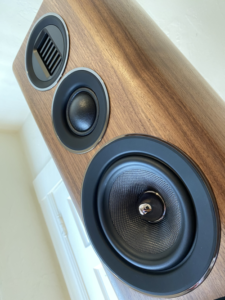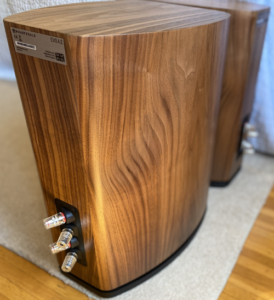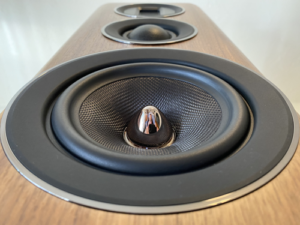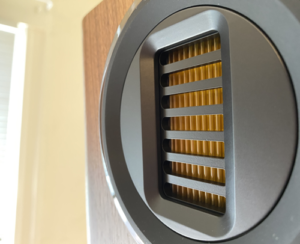
When I decided to write this Wharfedale EVO4.2 speaker review, I had no idea the company had been around since 1932. What have they learned in all those years? Let’s find out.
From the proprietary drivers and crossovers to the anti-resonant multi-layer cabinet materials, nearly everything that goes into a Wharfedale speaker is designed and manufactured in-house. The EVO4 series features trickle-down engineering and design influences from the company’s flagship ELYSIAN line. I found it interesting that lead designer Peter Comeau’s reference speaker is the famous Quad ESL. For the EVO4 line, Peter developed three different drivers: an AMT (Air Motion Transducer) style tweeter, woven Kevlar woofers, and on the 4.2 and above, a 2” dome midrange driver.
I haven’t seen any other speaker company offering this combination of drivers for under $1,000. Is it too good to be true, or is the EVO4.2 a standout gem? Read on to discover what I heard when I took a listen to these aggressively priced speakers.
Introducing the EVO4.2
The rarely seen 2” dome midrange is the most eye-catching part of the EVO4.2s. There are a few other speaker manufacturers who use similar dome midrange drivers, but they’re all priced dramatically higher than these Wharfedales. A 30x60mm AMT tweeter handles the treble frequencies. Rounding out the lower midrange and bass is a 6.5” Kevlar woofer. The woofer uses Wharfedale’s proprietary SLPP (Slot Loaded Profiled Port) technology. This forces the lowest bass energy to exit from a .4” vented slot on the bottom of the speaker which has been specifically designed to reduce distortion, extend low-frequency response, and increase speaker placement flexibility.
Upon unboxing the EVO4.2s, I gently ran my fingers over the smooth rounded edges of the cabinet, the matte black wood baseplate, and the anti-diffraction rubber trim rings surrounding the drivers. I admired the grain pattern of the walnut veneer and the overall quality and workmanship of the cabinets – they were flawless. This meticulous level of fit and finish for $999 is something I’d expect to find on speakers costing two to three times as much. Even before I took a listen, it was easy to see that you’re getting a lot of speaker for the money.
Presentation and Sound Quality
Two words: “holographic imaging”. Upon first listen, I was awestruck by the wide and expansive soundstage that was beaming forth from the EVO4.2s. The dome midrange and AMT tweeter demonstrated seamless driver integration as they joined forces to project an enveloping and layered sound that wrapped around my head.

The high-frequency reproduction is delicate and nuanced, and never sounded harsh or bright. It strikes a balance of being detailed and accurate, without sounding etched or offensive like other AMT designs I’ve heard. Wharfedale’s execution of the AMT successfully aligns with the company’s goal: creating a speaker that can be listened to for hours without listener fatigue.
The midrange performance might be what you notice most with the EVO4.2s, but the 2” dome doesn’t draw attention to itself. This is thanks to the driver integration and carefully designed crossovers. The midrange frequencies blend effortlessly with the treble and bass, and it results in a cohesive presentation. Tonally, the speaker is voiced slightly on the warm side of neutral which means piano, acoustic guitar, and male vocals all have pleasing weight and body.
The bass performance of these speakers is simply stunning. Wharfedale quotes a low bass extension down to 48hz, but after listening to them I feel like they are being conservative with this number. The SLPP design turns these 6.5” woofers into miniature downward firing subwoofers. They had no problem filling my room with clean bass, and despite how loud I cranked up the volume there was no port noises or chuffing. The bass was deep like a subwoofer, but the woofer’s performance was still nuanced and articulate in the upper bass and lower midrange frequencies. The SLPP design is effective at elevating the performance of these woofers and making them sound much bigger than they are.
Amplifiers and Wharfedale EVO4.2 Synergy

Norma Audio REVO IPA-140
Listening to the EVO4.2s with the Norma Audio IPA-140 integrated amplifier was the musical equivalent of snuggling up with a warm blanket. No matter how much I turned up the volume, the high frequencies never approached anything close to harsh or fatiguing. This made it a great pairing for modern music with more assertive peaks and treble energy. I was able to enjoy some of my favorite songs at intensely powerful volume levels, without the highs physically hurting my ears. The Norma Audio’s laid-back presentation also offered the most holographic midrange performance and devastating levels of bass output. It’s clear that these EVO 4.2s enjoy being driven by a powerful high-current amplifier.
Cambridge Audio Azur 851a
Compared to the Norma Audio integrated, the Cambridge Audio amp had more presence and energy emanating from the AMT tweeters. From top to bottom, the frequency response was flatter and more balanced. It reminded me of a typical “powered studio monitor” type sound. The EVO4.2s were fast, dynamic, punchy, clean, crisp, and accurate. There were still some holographic midrange imaging effects, but they weren’t as pronounced or obvious. This pairing excelled with high-energy electronic music with big basslines, thanks to how tight and fast the low-end response was. Everything was easily discernable in the soundstage, and it was easy to hear this amplifier’s lack of distortion.
Sony TA-A1ES
The Sony integrated amplifier demonstrated more inner detail and air in the treble and upper midrange. This additional depth added nuance and delicacy to the high-frequency information. The accuracy and tonality were impressive, particularly with well-recorded acoustic jazz and solo vocalists. Conversely, the interplay of complex elements within a recording resulted in great rhythmic drive and musicality. When I turned up the volume during “The Black Crowes – Ballad In Urgency”, the Sony made the Wharfedales truly rock. Chris Robinson’s striking voice was crystal clear and his brother Rich’s 1963 Gibson ES-335 guitar sounded shockingly realistic.
MastersounD BoX
This combination demonstrated the EVO4.2’s versatility, proving it to be a harmonious pairing with this 35wpc tube integrated. The BoX offers a linear presentation, without an overly warm midrange. This resulted in a pleasurable holographic presentation that didn’t feel overdone or fake. While some of the leading edge attack and transients were slightly softened, I was happy to discover there was more than enough power on tap for a richly layered room-filling sound.
Final Thoughts and Value

From the very first listen, the recurring thought during my time evaluating the EVO4.2s was, “How can a pair of speakers that cost under $1,000 sound this good?” I repeatedly tried to uncover a flaw or shortcoming in their performance or build quality, but ultimately I couldn’t. They perform well at low and high volumes, due to their rich and bold sound signature.
I challenge anyone who’s had an unpleasant experience with an AMT tweeter in the past to take a listen to these speakers. Wharfedale’s AMT tweeter isn’t designed to offer clinical or hyper-detailed levels of treble reproduction, yet still clearly replicates everything in the recording. As I discovered during my amplifier pairings, the EVO4.2s are highly resolving speakers, capable of showcasing the performance characteristics of the amplifier driving them.
Some audiophiles’ tastes may not align with the Wharfedale house sound. It proudly makes its unique voice heard, erring on the side of warmth and musicality. If you love long listening sessions and are sensitive to overly bright tweeters, the EVO4.2s are worth an audition.
Wharfedale’s decision to use an AMT with a dome midrange wasn’t a mere marketing gimmick. This unconventional driver combination delivers an exceptional listening experience.


A reviewer that actually has a Sony TA-A1ES!!
I was so close to buying one but the lack of reviews, and low wattage made me pick another brand 🙁
The inside looked like a work of art.
Hey! What do you think about drive these speakers by a valve amplifier?
Will it work? I like the natural & balance approach!`
Thanks
John L.
Thank you, John, for the question. This is Jack’s response. Of course, they were originally driven by the Quad II amps. Many people prefer them with tube amps. He is currently using a hybrid.
Hi!
I am confused.of what’s the real Sensitivity of Wharfedale Evo 4.2. Is it 90db, 88db or 87db?
Hi Danny – Per Wharfedale UK, the EVO4.2 is rated at 87db sensitivity.
Really considering these..just wonder if they would over-energize an 11×12 room with 3 windows, 8.5 foot ceiling and limited treatment?
Hi John – Thanks for the comment and for reading! I had them in a 13×10 room and I’d say as long as you can give them some distance away from the front wall and the corners, they shouldn’t over-energize or overload the room.
Of course it will depend on what type of music you regularly play, and the volume at which you play it. They do have substantial bass energy! It’s most noticeable with expressive and dynamic bass-heavy electronic music.
Hi,
I have a Cambridge 851a and listen to a lot of varied music, but mainly a lot of country and folk music. I do like a clear top end but find that some speakers have too harsh a sound on the very top end, but am looking for something that is clear and balanced, and versatile. From johnny cash to pink floyd, to Marvin Gaye to Joni Mitchell, and anything inbetween
Would you recommend this speaker for the job?
I’m struggling to find somewhere local to demo them.
Thanks
Josh
Hi Josh – Thanks so much for reading and for your comment!
To answer your question, I think the EVO4.2 speakers would be a great fit for the types of music that you mentioned. They’re a real “do-anything” type speaker and they sound great with many genres. Their top-end isn’t harsh at all, so I think you will love the way that they have implemented the AMT tweeter!
In regards to a sound demo, I would suggest ordering from an online retailer such as Crutchfield or Music Direct, both of which have liberal return policies. That way you get to try them in your own listening room, which is the only way to be sure they will work for you.
Hi, I currently have older Wharfedales Pacific Evo 30 floor standers that I had in my basement system. I’ve moved those back to my main system after a failed experiment with expensive stand mounted speakers. Would the Evo 4.2 work with a 60 watts per side Cambridge Integrated?
Hi Mark! To answer your question, I think it ultimately would depend on your room size and the genres of music that you listen to. However, my instinct is that 60wpc would be just fine for the EVO4.2s!
Have fun and let me know how they sound if you end up giving them a try.
Great review! I own the Wharfedale EVO 4.2s and absolutely love them!
They are now part of my living room setup (new baby turned man cave / office into a nursery) so besides being my main listening it’s also part of a 2.1 setup for movies (w/ DefTech SuperCube 2000 sub).
However, I’d like to swap out the Sonos AMP that’s powering them and was wondering if you have any specific recommendation for a power amp at about $1,000 USD.
I am looking at Emotiva XPA-2 Gen-3, and will add a DAC or pre-amp separately. Thoughts?
Thanks!!
Hi GX Perez,
I’m happy to hear you are enjoying your EVO 4.2s in a mixed-use environment!
I don’t have any experience with Emotiva amplifiers, but the specifications on the one you mentioned look pretty good.
I know that Parasound amplifiers generally do very well in hybrid music/HT systems, so you might look at the Parasound NewClassic 2125 v.2 (150wpc) or the more powerful 2250 v.2 (275wpc).
Good luck and let us know what you end up with!
any problem with Sonos AMP powering your Evo 4.2 ?
Hi, a bit late to the party, but I’m looking at the Evo 4.2s and pairing them with the Rega Brio.
Does anyone have experience of this pairing, or could give technical or sonic reasons why they may not.
Thanks in advance
Lyndon
I’ve been enjoying these speakers for a few months now and feel they are a great buy with serious, listenable sound, and as as your review states, they go low with plenty of defined bass in my smallish room. They are very musical speakers. i’m driving them with old NAD 1300 Pre and Bryston 3B amps and they need no where near the power the Bryston can provide, at least for volume levels I prefer.